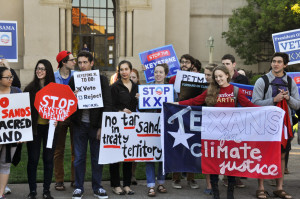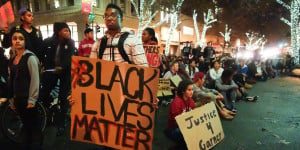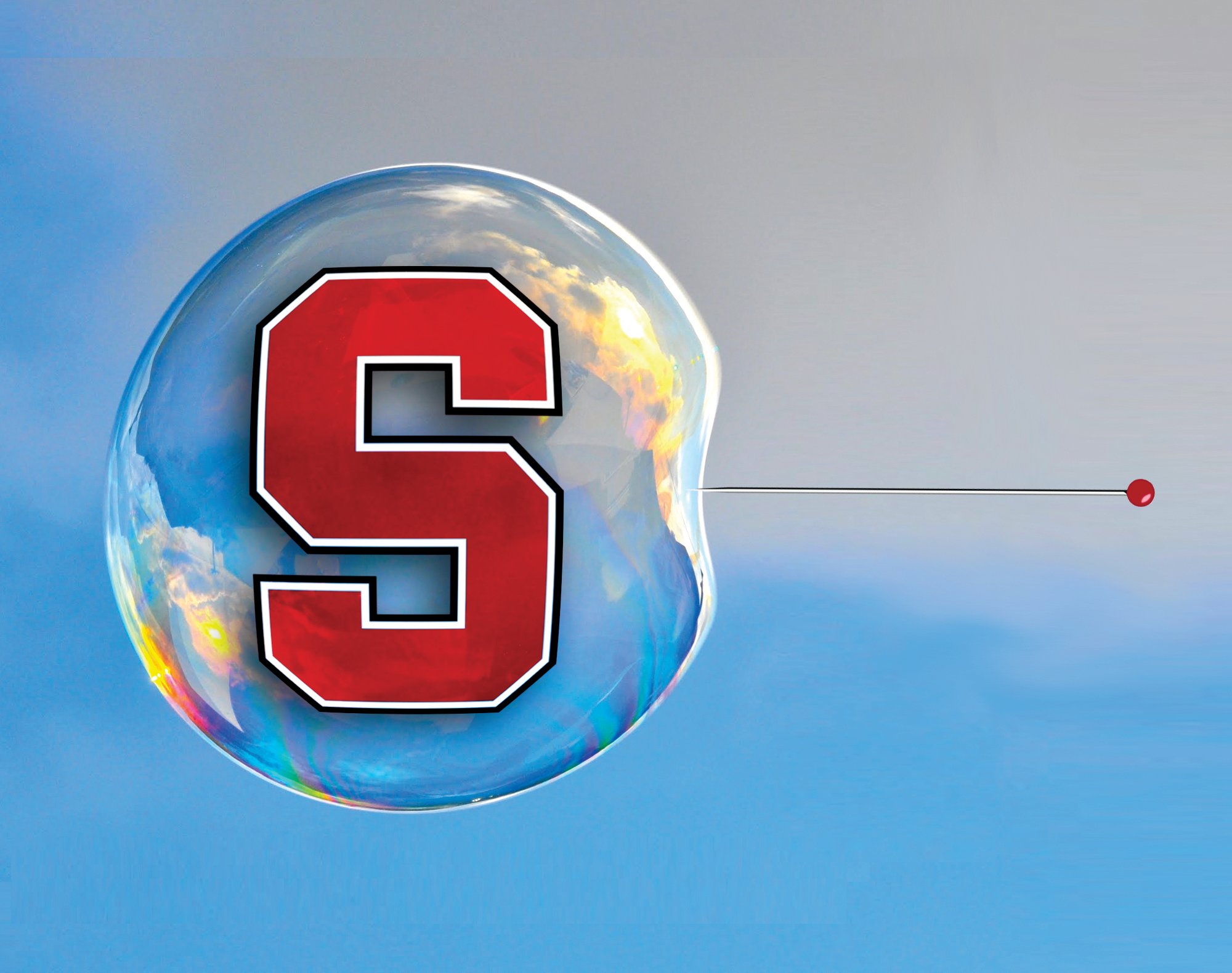Just over a year ago, the University announced the closing of popular sandwich eatery Ike’s Place, much to the chagrin of students who had enjoyed its being a delicious alternative to dining halls and other food outlets operated by Residential & Dining Enterprises (R&DE). A small group of students organized a protest in White Plaza, but the effort seemed light and expressive rather than one that actually expected to save Ike’s.
If this year’s activism had been twice as intense as the Ike’s protest, the campus climate would still have been considered tame. “I absolutely feel that the campus climate is different, when last year, with the exclusion of [the Stand with Leah movement] at the very end of the year, the most activism we saw was about Ike’s,” said Deborah Golder, Associate Vice Provost for Student Affairs.
After a historic meeting of the 16th Undergraduate Senate on Feb. 17, though, tension that had been mounting throughout the year finally reached a tipping point. On a campus known more for its startups than its activism, and on a campus known for its “bubble” that insulates students from the world at large, the campus climate was arguably more tumultuous than it had been at any point in recent history. Had the Stanford bubble finally burst?
Four movements converge

Though movements such as Fossil Free Stanford’s “Divest the Rest” campaign have seen significant rallies, petitions and marches, the most charged student activism on campus has centered around four main areas: Black Lives Matter, divestment, mental health and sexual assault.
After the deaths of Michael Brown and Eric Garner over the summer and the subsequent no-indictment decisions for the police officers involved, coalitions on campus started to form to discuss and protest the decisions and make students aware of the national issue. Most notable of the coalitions was the Palo Alto State of Emergency group comprising members from various social justice groups in the Stanford community. With the Silicon Shutdown demonstration, the #HandsUpWalkOut event and the obstruction of Highway 101 all occurring during “Dead Week” of fall quarter, campus activism had reached a turning point.
Another coalition simultaneously sprung up around an international human rights cause, that of the Israel-Palestine conflict. In October, Stanford Out of Occupied Palestine (SOOP) called for divestment “from companies that enable and benefit from collective punishment, mass incarceration and the militarization of the police in Palestine and elsewhere.” SOOP’s petition for a resolution garnered over 1,700 signatures.
Siddharth Patel, a graduate student and co-president of Stanford Students for Justice in Palestine (SJP), noted that the student activism fell in line with recent international attention and drive on the issue.
“Several divestment resolutions passed on campuses throughout the country,” Patel said. “The needle has shifted in terms of international sympathy with [Palestine] and recognition that something fundamentally unjust is happening with Palestinians.”
The two movements — Black Lives Matter and divestment — merged during the San Mateo-Hayward bridge protest, during which a Palestinian flag was displayed alongside signs supporting the Ferguson Action national demands.
According to some leaders of the Students of Color Coalition (SOCC), the specific state-sanctioned violence that both the divestment and Black Lives Matter campaigns claim to target has been an ongoing concern of students since well before this year.
“The tension has always been present because the issues students have always been pushing for have been consistently not met, throughout our time at Stanford and before,” said Tianay Pulphus ‘15, president of Stanford’s NAACP chapter. “I think what you’re seeing this year is students being vocal about the fact that they’re frustrated about these decisions that the University has made or not made.”
Mental health also proved to be a contentious issue going into the spring ASSU elections, as Counseling and Psychological Services (CAPS) was called out for its lack of resources. Last year’s Stand with Leah movement brought attention to the prevention of and education on sexual assault, a concern on college campuses nationwide. Discussion on the topic continued this year with the new Title IX office’s sexual assault and harassment investigations into Sigma Alpha Epsilon (SAE), the Leland Stanford Junior University Marching Band (LSJUMB) and others.
One of the four issues — Black Lives Matter, divestment, mental health and sexual assault — was brought into the University’s spotlight when the ASSU Undergraduate Senate heard hundreds of students express their opinions on divestment. After the resolution fell short of the required vote count in Senate but then was reversed a week later, claims that campus climate had taken a turn toward the divisive began.
The bubble bursts
Immediately following the passage of the resolution, which some members of the campus community felt was slipped under the table, social media, especially anonymous outlets like YikYak, exploded in a frenzy of name-calling, personal attacks and unrelenting outrage. The vote made international news, and some students believed the Senate had inappropriately made a bold political statement, outside the scope of its jurisdiction, that would only reflect negatively on the Stanford name.

Ramah Awad ‘17, co-president of SJP, thought of the vote not only as a victory for those who wished to send a message to the University but also as creating a space for discussion around an important global issue.
“During the campaign, divestment brought a lot of people to the table, and although we don’t always agree on end goals [and] we don’t always agree on strategy … the campaign really created a space for people to come and engage,” Awad said.
President Hennessy seemed to think that the engagement went too far, though. At the next Faculty Senate meeting, he read a statement noting “[an] atmosphere of intimidation or vitriol” at Stanford and encouraging “civil and rational discussion.”
Furthermore, the most recent Stanford Magazine cover story claimed that the administration is “worried that the divestment movement could endanger the university’s reputation, especially with Jewish families.” Alumni have been concerned with how the resolution has reflected on Stanford’s image, according to Howard Wolf, vice president for alumni affairs.
“Essentially all alumni from whom I have heard on this topic strongly disagree with the divestment from Israel agenda and were highly disappointed that the ASSU Senate voted in favor of such a proposal,” Wolf said. “Alumni are engaged with both students and the administration about the issues. The reason for this engagement is that they care deeply about Stanford and its future.”
As the campus saw dialogue became even more acrimonious, Provost John Etchemendy took his turn to make a statement at the April Faculty Senate meeting: “We seem to have lost the ability to engage in true dialogue. Dialogue is not monologue times two. The essential feature of dialogue is not speaking but listening: listening with respect and then expressing, in turn, one’s own view with clarity, rather than volume.”
The Provost’s statement also claimed that organizations endorsing candidates for the upcoming ASSU elections may have been preventing open-mindedness and true dialogue. Despite emphasizing that he was “not singling out any one group,” many perceived a connection to the allegations against SOCC that interviewers inappropriately asked then-candidate Molly Horwitz ’16 about her Jewish identity in an endorsement interview and made candidates sign “loyalty oaths.”
Students responded to the statement on the Diaspora email listserv, most notably Manny Thompson ’14 and Senator Malcolm Lizzappi ’17. Thompson, one of the leaders of the activist community, attacked the Provost for what he perceived were empty promises of dialogue and change.
“Sexual assault, police brutality against black and brown bodies, Israeli apartheid and unfounded attacks against SOCC perpetrated by [The Stanford] Review have been going on for years, and Etchemendy and the university have remained silent,” he wrote in the email. “The administration didn’t create space for dialogue on their own because they’ve never really been interested in dialogue. They’re interested in Stanford’s brand, because that’s what fills their pockets. They’re interested in perpetuating the status quo.”
Invoking the Black Power movement in his closing, Thompson wrote that he would prefer violent resistance to dialogue, which may have driven the Provost to personally respond, asking to meet to discuss these issues. Thompson declined the Provost’s invitation, writing that “dialogue for the sake of dialogue isn’t some magic remedy.” He instead listed demands for change that included divestment as well as action to “hire Black CAPS counselors, increase faculty diversity and stop giving rapists degrees.”
“Talking to one another is the only way I know to clarify misunderstandings and make forward progress,” Etchemendy replied.
Many were put off by these interactions between student activists and the Provost, even to the point of creating a website and petition to recall Lizzappi because of his “objectionable” comments in the email thread.
Former Senate candidate Brooks Hamby ‘18 was surprised that students could be so opposed to dialogue.
“Provost Etchemendy issued a simple call for calm,” Hamby said. “It’s perplexing that there are a few students who are fundamentally opposed to the idea of having discussion and sharing ideas with people that they disagree with. College is supposed to be about a free exchange of ideas, ultimately letting students decide their own views based on as many facts and opinions as possible — not less. More views, more perspectives and greater student debate and engagement will bring us to a better place, not a worse one.”
Anonymous aggression
With the whirlwind of what some termed “divisiveness” on campus, anonymous forums again became the method of choice for students to express their thoughts, feelings and concerns on the campus climate. Posts contemplating suicide, attacking individuals and making light of oppression pervaded Yik Yak and Whatsgoodly, leading to op-eds condemning the use of anonymous platforms for bullying purposes.
Immediately following the announcement of the Title IX investigation of LSJUMB, students claiming to be seniors posted disheartening thoughts about the campus climate this year, saying “Stanford isn’t an enjoyable place anymore” and “Sooooo glad I actually got to experience a fun, carefree and crazy Stanford.”
Where do we go from here?
The campus climate has changed — but does that mean any divisiveness has changed campus for the worse?
Dereca Blackmon ’91, director of Diversity and First-Gen Education and Training, said there is reason to have hope.
“There has been an ebb and flow,” Blackmon said. “I think it’s helpful for students … to not feel like, we’re never going to get through this, this is impossible and it’s destroying the fabric of Stanford. That’s not really the case. The truth is that the University has grown tremendously through these kinds of changes in the past.”
Although Ike’s most likely will not be returning to campus, the University is working on developing a plan of action over the summer to address the concerns raised on the four major issues, according to Vice Provost for Undergraduate Education Harry Elam.
“What we’re preparing for in the fall is something that is still unclear, but a way of really finding space to have, campus-wide, a greater side of listening and hearing and conversation about issues,” Elam said. “How we do that? We haven’t really mapped it out yet — don’t have a plan for it. But the determination is there on the part of the administration that [we] feel it’s important that we help in the situation in any way we can.”
While none of the issues have been solved, most would agree that progress has been and will continue to be made, whether that comes in the form of institutional change or the vital role that awareness has played this year.
Vice Provost for Student Affairs Greg Boardman said that for all the engagement that the school has witnessed this year, there is a silent majority that the administration would still like to hear from.
“There are a lot of students who aren’t engaged in the dialogue, and either run away from it, dismiss it, don’t engage, and there are some who don’t really want to learn about the issues either,” Boardman said. “So I see the University’s role also as trying to find venues to engage students more broadly, too, because there are a lot of students who haven’t participated in these conversations.”
Contact Tristan Vanech at tvanech ‘at’ stanford.edu
